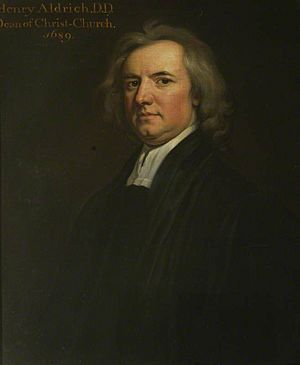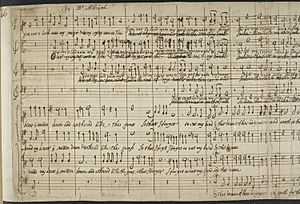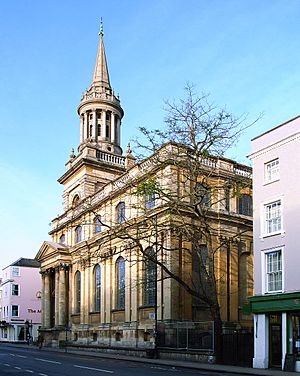Henry Aldrich facts for kids
Henry Aldrich (born January 15, 1648 – died December 14, 1710) was a very talented English person. He was a church leader, a deep thinker, an architect who designed buildings, and even a musician who wrote songs. He lived a long time ago, during a period when England was changing a lot.
Contents
Life of Henry Aldrich
Henry Aldrich went to a famous school called Westminster School. In 1662, he started studying at Christ Church, Oxford, which is a college at Oxford University.
Becoming a Dean
In 1689, he became the Dean of Christ Church. A Dean is like the head of a college. He took over from John Massey, who had left the country. From 1692 to 1695, Aldrich also served as the Vice-Chancellor of the University of Oxford. This role is like being a top leader for the entire university.
Later Years and Legacy
In 1702, he was given another church role as the Rector of Wem in Shropshire. However, he chose to stay in Oxford. He passed away on December 14, 1710. Henry Aldrich was buried in Christ Church Cathedral. He asked not to have a special memorial. But later, in 1732, a medallion portrait was put up in Oxford Cathedral to remember him.
Henry Aldrich's Many Talents
Henry Aldrich was known for having many different skills. He was good at studying old classical texts. He is most famous for a small book he wrote about logic. Logic is the study of correct reasoning.
His Book on Logic
His book was called Artis Logicæ Compendium. While it didn't introduce new ideas in logic, it was very good at explaining things clearly. Many generations of students at Oxford University used his book. It helped them understand logic for a very long time.
His Musical Works
Aldrich also wrote many beautiful church songs called anthems. He created music for church services too. He was very skilled at taking music by famous composers like Palestrina and Carissimi and adapting it to English words. He also wrote a well-known fun song called "Hark, the bonny Christ Church bells."
His Architectural Designs
Henry Aldrich was also a talented architect. You can see his building skills in All Saints Church, Oxford. He designed the church and its bell tower. He also designed three sides of the Peckwater Quadrangle at Christ Church. A quadrangle is a courtyard surrounded by buildings.
His Sense of Humor
Aldrich was known for being a cheerful person. He even wrote a funny Latin version of a popular song. He also wrote a clever poem about why people might drink. It lists five reasons:
- Good wine
- A friend
- Being thirsty
- Thinking you might get thirsty later
- Or any other reason!
His Personal Library
Henry Aldrich had a very large personal library. It had about 3,000 books, 8,000 pieces of music, and 2,000 engravings. Engravings are like detailed pictures made by carving into a surface. He left all these valuable collections to Christ Church when he passed away. His collection of engravings is one of the oldest surviving English collections of its kind.
Images for kids
See also
 In Spanish: Henry Aldrich para niños
In Spanish: Henry Aldrich para niños






